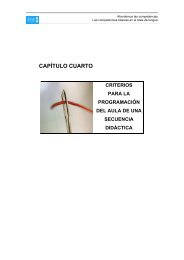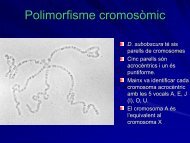Geological and environmental implications of the evaporite karst in Spain
Geological and environmental implications of the evaporite karst in Spain
Geological and environmental implications of the evaporite karst in Spain
You also want an ePaper? Increase the reach of your titles
YUMPU automatically turns print PDFs into web optimized ePapers that Google loves.
Environ Geol (2008) 53:951–965 955<br />
salt structures has <strong>in</strong>duced <strong>the</strong> development <strong>of</strong> deeply <strong>in</strong>cised<br />
<strong>karst</strong>ic canyons, like <strong>the</strong> Guadalhorce River canyon<br />
<strong>and</strong> <strong>the</strong> Martín Arroyo (Durán 1984), <strong>and</strong> perched spr<strong>in</strong>gs<br />
<strong>and</strong> caves like <strong>the</strong> El Aguila Cave (Calaforra 1998). This<br />
cave, developed at <strong>the</strong> contact between gypsum <strong>and</strong> carbonate<br />
rocks, reaches 120 m <strong>in</strong> depth <strong>and</strong> conta<strong>in</strong>s a<br />
chamber 25 m high <strong>and</strong> about 200 m 2 <strong>in</strong> area.<br />
The existence <strong>of</strong> halite at depth is evidenced by <strong>the</strong><br />
hydrochemistry <strong>of</strong> <strong>the</strong> spr<strong>in</strong>g waters. The Meliones Spr<strong>in</strong>g,<br />
with a mean discharge <strong>of</strong> 1–2 l/s, has an electrical conductivity<br />
higher than 200,000 lS/cm. This spr<strong>in</strong>g, located<br />
<strong>in</strong> <strong>the</strong> upstream sector <strong>of</strong> <strong>the</strong> Guadalhorce River reservoir,<br />
issues around 5,000–10,000 tons <strong>of</strong> sodium chloride per<br />
year, caus<strong>in</strong>g a severe degradation <strong>of</strong> <strong>the</strong> reservoir waters<br />
that supply Malaga city. Several measures have been attempted<br />
to mitigate <strong>the</strong> problem, but with no success. An<br />
attempt was made to prevent <strong>the</strong> water outflow by drill<strong>in</strong>g<br />
boreholes directly <strong>in</strong>to <strong>the</strong> spr<strong>in</strong>g. Additionally, several<br />
dol<strong>in</strong>es <strong>and</strong> cave entrances, <strong>in</strong>clud<strong>in</strong>g <strong>the</strong> El Aguila Cave,<br />
were sealed with compacted clays <strong>and</strong> concrete to reduce<br />
water recharge <strong>of</strong> <strong>the</strong> <strong>karst</strong>ic aquifer (Fig. 2a). Obviously,<br />
this measure did not reduce <strong>the</strong> discharge <strong>in</strong> <strong>the</strong> Meliones<br />
Spr<strong>in</strong>g, fed by deep underground flows, <strong>and</strong> it caused a<br />
serious adverse impact on <strong>the</strong> <strong>karst</strong> environment <strong>and</strong> its<br />
protected subterranean fauna. Recently, <strong>the</strong> adm<strong>in</strong>istration<br />
has proposed construction <strong>of</strong> a desal<strong>in</strong>ization plant downstream<br />
<strong>of</strong> <strong>the</strong> Guadalhorce Dam.<br />
The Antequera Triassic outcrops also conta<strong>in</strong> a large<br />
number <strong>of</strong> ephemeral lakes <strong>of</strong> great <strong>environmental</strong> value<br />
constitut<strong>in</strong>g <strong>the</strong> so-called ‘‘Betic endorheism’’ (Durán <strong>and</strong><br />
López-Martínez 1999). The orig<strong>in</strong> <strong>of</strong> <strong>the</strong>se closed depressions<br />
is largely related to subsidence phenomena caused by<br />
ris<strong>in</strong>g groundwater flows. The most outst<strong>and</strong><strong>in</strong>g example<br />
corresponds to <strong>the</strong> Fuente de Piedra Lake, <strong>in</strong>cluded <strong>in</strong> <strong>the</strong><br />
Fig. 2 a Seal<strong>in</strong>g with<br />
compacted clays <strong>and</strong> concrete <strong>of</strong><br />
<strong>the</strong> s<strong>in</strong>khole that gives access to<br />
<strong>the</strong> El Águila Cave to prevent<br />
water recharge. The natural<br />
entrance to <strong>the</strong> cave was<br />
deteriorated with construction<br />
<strong>of</strong> a concrete structure. b<br />
S<strong>in</strong>khole result<strong>in</strong>g from <strong>the</strong><br />
upward stop<strong>in</strong>g <strong>of</strong> cavities<br />
generated by solution m<strong>in</strong><strong>in</strong>g <strong>in</strong><br />
<strong>the</strong> Triassic <strong>evaporite</strong>s <strong>of</strong> <strong>the</strong><br />
Polanco Diapir. c Mio-Pliocene<br />
sediments <strong>in</strong> Teruel Graben<br />
(Iberian range) affected by a<br />
monocl<strong>in</strong>al flexure generated by<br />
<strong>the</strong> <strong>in</strong>terstratal <strong>karst</strong>ification <strong>of</strong><br />
Triassic <strong>evaporite</strong>s. d General<br />
view <strong>of</strong> Gallocanta Lake<br />
(Iberian Range)<br />
Ramsar Convention <strong>of</strong> Wetl<strong>and</strong>s (Fig. 1). This sal<strong>in</strong>e lake,<br />
with sodium-chloride waters, covers 13.6 km 2 <strong>and</strong> hosts<br />
<strong>the</strong> largest breed<strong>in</strong>g colony <strong>of</strong> flam<strong>in</strong>gos (Phoenicopterus<br />
rubber) <strong>in</strong> <strong>the</strong> Iberian Pen<strong>in</strong>sula.<br />
The Vallada <strong>karst</strong><br />
The Vallada <strong>karst</strong>, located <strong>in</strong> <strong>the</strong> transitional zone between<br />
<strong>the</strong> Betic Cordillera <strong>and</strong> <strong>the</strong> Iberian Range, is developed <strong>in</strong><br />
a diapiric structure made up <strong>of</strong> <strong>the</strong> Upper Triassic Keuper<br />
facies. Outcropp<strong>in</strong>g sediments <strong>in</strong>clude massive gypsum,<br />
shales, marls <strong>and</strong> dolomite beds. The structural evidence <strong>of</strong><br />
diapirism <strong>and</strong> <strong>the</strong> presence <strong>of</strong> sal<strong>in</strong>e spr<strong>in</strong>gs <strong>in</strong>dicate <strong>the</strong><br />
existence <strong>of</strong> halite <strong>in</strong> <strong>the</strong> subsurface. The most remarkable<br />
feature corresponds to <strong>the</strong> 210 m deep El Sumidor Cave,<br />
which is <strong>the</strong> second deepest gypsum cave <strong>in</strong> <strong>the</strong> world. The<br />
large shafts <strong>of</strong> this cave are mostly carved <strong>in</strong> gypsum units<br />
juxtaposed aga<strong>in</strong>st steeply dipp<strong>in</strong>g dolomite beds. Although,<br />
calcium-sulfate waters flow through <strong>the</strong> El Sumidor<br />
Cave, <strong>the</strong> spr<strong>in</strong>g that dra<strong>in</strong>s <strong>the</strong> system, located 400 m<br />
beyond <strong>the</strong> lowermost accessible po<strong>in</strong>t <strong>of</strong> <strong>the</strong> cave, issues<br />
water <strong>of</strong> <strong>the</strong> sodium-chloride hydrochemical facies. This<br />
hydrochemical change, toge<strong>the</strong>r with an <strong>in</strong>crease <strong>in</strong> <strong>the</strong><br />
discharge <strong>and</strong> temperature <strong>of</strong> water <strong>in</strong> <strong>the</strong> spr<strong>in</strong>g, is<br />
attributed to <strong>in</strong>corporation along <strong>the</strong> last 400 m long reach<br />
<strong>of</strong> <strong>the</strong> flow path <strong>of</strong> NaCl-rich upward flows com<strong>in</strong>g from<br />
deep halite bodies (Calaforra 1998).<br />
Evaporite <strong>karst</strong> <strong>in</strong> Triassic formations <strong>of</strong> <strong>the</strong> Pyrenees<br />
Outcrops <strong>of</strong> Triassic <strong>evaporite</strong>s <strong>in</strong> <strong>the</strong> Pyrenees are usually<br />
situated <strong>in</strong> <strong>the</strong> core <strong>of</strong> anticl<strong>in</strong>al structures <strong>and</strong> diapirs. The<br />
circulation <strong>of</strong> groundwater through <strong>the</strong> upper part <strong>of</strong> diapiric<br />
bodies, that commonly bear large volumes <strong>of</strong> halite at<br />
123





